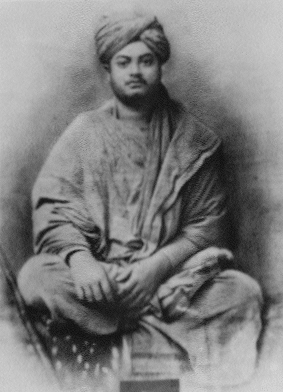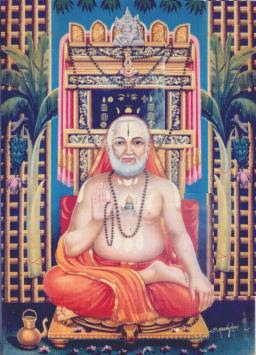
Swami Vivekananda
(1863 - 1902)
Swami Vivekananda is just another name for the phenomenon that exploded on the Indian scene towards the end of the nineteenth century and restored the self-confidence and self-respect of a nation that had been badly mauled for millennia. Born on the 12th January 1863, of an intellectual but compassionate father and a deeply religious mother, Narendranath - that was his original name - got a good education and cultural training under them. An innate desire for spiritual perfection brought him into contact with Sri Ramakrishna in the early part of 1882. The next four and a half years - until the Mahasamadhi of Sri Ramakrishna - were marked by turbulence and turmoil, the direct result of the perfect Master chiselling and shaping the perfect disciple, but ending in total submission of the latter to the former. As per the specific direction of his guru, Narendra along with the other young men who were his co-disciples, took to monastic orders and found a monastery in his guru's name at Baranagore (Calcutta) in 1886. Setting out on pilgrimage, mostly as a wandering monk, he finally arrived at Kanyakumari, the southernmost tip of the Indian soil, sometime during 1892. There, while meditating on the rock inside the sea, the mission of his life was revealed to him. Then, things moved quickly. Setting sail for America on the 31st May 1893, he created history at the World Parliament of Religions held at Chicago during September of the same year. After whirlwind tours in America and England, he triumphantly returned to India via Colombo on the 15th January 1897. During the next five years he literally shook the Indian nation to its foundations, electrifying it to dynamic self-expression, through his speeches and writings as also conversations. These have been compiled and published in eight volumes, now well-known as `The Complete Works of Swami Vivekananda.' They contain, as he himself once remarked, enough messages for a millennia. He formally established the Ramakrishna Mission in 1897 and consecrated the newly built Belur Math, the Head-quarters of the Ramakrishna Monastery, in 1899. He shuffled off the mortal coil on the 4th of July 1902. His was a multifaceted personality - a prophet, a patriot, a monk, a yogi, a social reformer, an educationalist, an artist, a poet and a humanist - all rolled into one. His dynamic life and message gave a new direction to the resurgent India. His work is being continued today by the Ramakrishna Math and the Ramakrishna Mission, the twin organizations that he established with the motto: Atmano mokshartham jagaddhitya ca, `For the sake of self-realization and the good of mankind.' The Math is unique in that it has charted new avenues in Indian monasticism. The Mission is an ideal service organization embodying the teachings of practical Vedanta.
Teachings
One way for attaining bhakti is by repeating the name of God a number of times. Mantras have effect - the mere repetition of words ... To obtain bhakti, seek the company of holy men who have bhakti and read books like the Gita.
Our first duty is not to hate ourselves; because to advance we must have faith in ourselves first and then in God. He who has no faith in himself can never have faith in God.
Every duty is holy, and devotion to duty is the highest form of worship of God.
Education is the manifestation of the perfection already in man.
To me the very essence of education is concentration of mind, not the collecting of facts.
That society is the greatest, where the highest truths become practical.
Faith, faith, faith in ourselves, faith in God - this is the secret of greatness ... Have faith in yourselves, and stand up on that faith and be strong; that is what we need.
The Hindus were bold, to their credit be it said, bold thinkers in all their ideas, so bold that one spark of their thought frightens the so-called bold thinkers of the West.
In my opinion, a race must first cultivate a great respect for motherhood, through the sanctification and inviolability of marriage.
Renunciation and service are the twin ideals of India. Intensify her in these channels and the rest will take care of itself.
